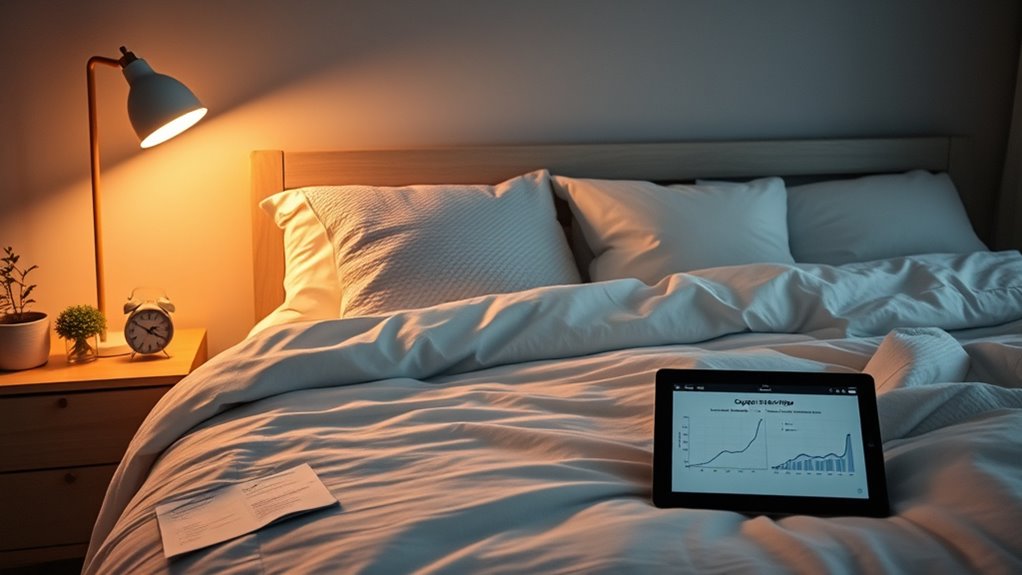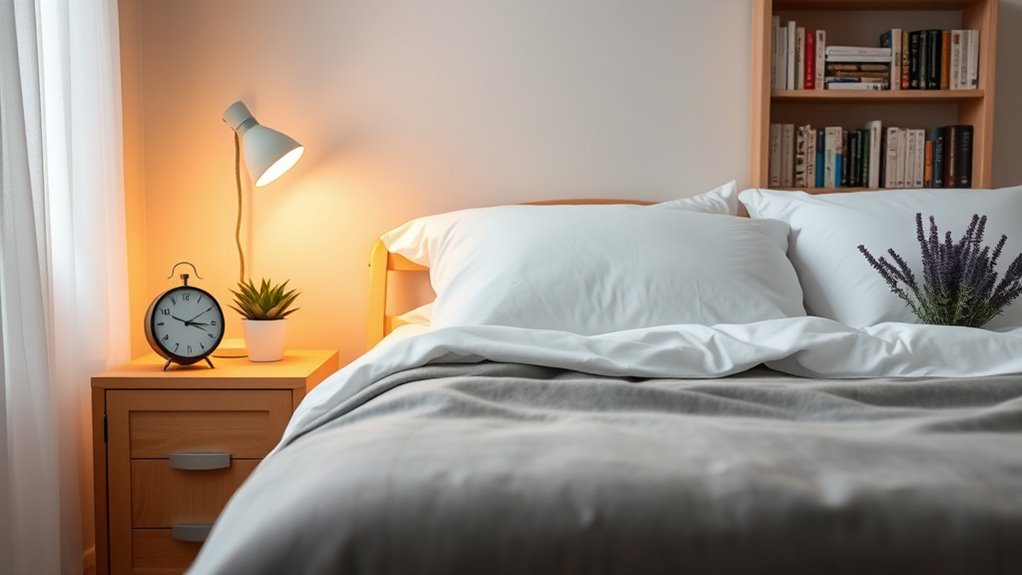CBT‑I techniques focus on changing negative thoughts and behaviors that cause sleep problems. You’ll learn to establish a consistent sleep schedule and avoid caffeine or screens before bed. Relaxation exercises like deep breathing and muscle relaxation help you wind down. Building a calming pre-sleep routine trains your body to associate specific habits with sleep. As you adopt these strategies, you’ll improve your sleep habits over time—keep exploring to discover how each step works for better rest.
Key Takeaways
- CBT-I focuses on changing negative thoughts and behaviors that contribute to insomnia for long-term sleep improvements.
- It includes sleep hygiene education, such as maintaining consistent sleep schedules and creating a sleep-friendly environment.
- Relaxation exercises like deep breathing, progressive muscle relaxation, and guided imagery are core components to reduce stress.
- Establishing a regular pre-sleep routine and practicing relaxation techniques consistently help condition the body for sleep.
- CBT-I aims to develop sustainable sleep habits and thought patterns, promoting better sleep without medication.

Have you ever wondered how to overcome insomnia using proven methods? One effective approach is through Cognitive Behavioral Therapy for Insomnia, or CBT-I. This therapy focuses on changing the thoughts and behaviors that keep you awake at night. A core component of CBT-I involves improving your sleep hygiene, which encompasses habits and environmental factors that promote restful sleep. You’ll want to establish a consistent sleep schedule, meaning going to bed and waking up at the same time every day—even on weekends. Avoid caffeine, nicotine, and heavy meals close to bedtime, and create a sleep-friendly environment by keeping your bedroom cool, dark, and quiet. Removing screens from your bedroom can also help, as the blue light emitted by phones and computers suppresses melatonin production, making it harder to fall asleep.
Alongside sleep hygiene, relaxation exercises play a crucial role in calming your mind and body before bedtime. Techniques such as deep breathing, progressive muscle relaxation, and guided imagery help to reduce stress and anxiety that often contribute to insomnia. For example, you can try inhaling slowly through your nose for a count of four, holding your breath briefly, then exhaling gently for a count of four. Repeating this pattern signals your nervous system to relax. Progressive muscle relaxation involves tensing and then releasing muscle groups, starting from your toes and working up to your face, which helps release physical tension accumulated throughout the day. Guided imagery takes you through calming mental scenes, such as a peaceful beach or a quiet forest, distracting your mind from racing thoughts that interfere with sleep. Incorporating exercising regularly can also help improve sleep quality and overall health.
Implementing these relaxation exercises as part of your nightly routine can profoundly improve your ability to fall asleep and stay asleep. The key is consistency—doing these exercises regularly trains your body to associate them with sleep, creating a calming pre-sleep ritual. Coupled with good sleep hygiene practices, relaxation techniques can reduce the time it takes for you to drift off and enhance overall sleep quality. Remember, CBT-I isn’t just about medication or quick fixes; it’s about establishing new habits and thought patterns that foster healthy sleep over the long term. By prioritizing sleep hygiene and incorporating relaxation exercises into your routine, you take active steps toward overcoming insomnia and enjoy more restorative, restful nights.
Frequently Asked Questions
Can Cbt‑I Be Used Alongside Medication for Insomnia?
Yes, you can use CBT‑I alongside medication for insomnia. Combining treatments often creates medication synergy, making it more effective than either alone. This combined treatment approach helps you manage symptoms better while addressing underlying issues. Always consult your healthcare provider to make sure your medication and CBT‑I plan are tailored to your needs, maximizing benefits and minimizing potential side effects. This strategy can lead to more sustainable, long-term sleep improvements.
How Long Does It Typically Take to See Results With Cbt‑I?
Think of your sleep pattern as a garden that needs time to bloom. You might start noticing improvements within 1 to 2 weeks, but significant changes often take 4 to 8 weeks. The treatment timeline varies based on your commitment and individual factors. Consistency is key, and with patience, you’ll see your sleep quality improve as new habits take root, leading to restful nights ahead.
Is Cbt‑I Effective for Chronic Versus Occasional Insomnia?
CBT‑I is effective for both chronic and occasional insomnia, but the effectiveness comparison varies. For chronic insomnia, it often shows significant improvements over a longer treatment duration, typically several weeks to months. With occasional insomnia, you may notice quicker results, sometimes within a few sessions. Overall, consistent effort and adherence to techniques boost success, regardless of whether your insomnia is persistent or sporadic.
Are There Any Side Effects or Risks Associated With Cbt‑I?
You might wonder if CBT-I has potential side effects or risks. Generally, it’s considered safe with minimal risks. Some individuals may experience temporary discomfort, like increased anxiety or frustration when adjusting sleep habits. To manage this, your therapist will guide you through risk management strategies, ensuring you understand the process and feel supported. Overall, CBT-I’s benefits in improving sleep usually outweigh any minor, manageable side effects.
Can Children or Teenagers Benefit From Cbt‑I for Sleep Issues?
Yes, children and teenagers can benefit from CBT‑I for sleep issues. You’ll find that age-specific adaptations and developmental considerations help tailor the therapy to their needs, making it more manageable and effective. By addressing their unique sleep struggles through supportive and structured sessions, you can help young minds develop healthier sleep habits. This personalized approach guarantees that the therapy is suitable, safe, and successful for different age groups.
Conclusion
By understanding CBT‑I techniques, you can challenge restless thoughts, establish healthy sleep habits, and create a calming bedtime routine. By practicing consistently, you can break the cycle of insomnia, regain restful nights, and wake up refreshed. Embrace these methods, stay committed to your sleep goals, and take control of your nights. With patience and perseverance, you’ll find yourself sleeping soundly, feeling energized, and enjoying the benefits of better sleep every day.








